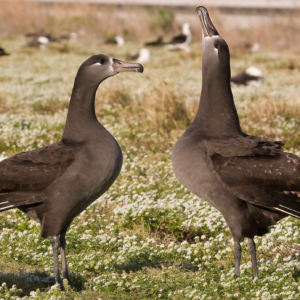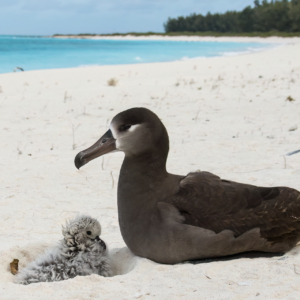Black-footed Albatross
Click on an image to enlarge it
Status: Indigenous to Hawai‘i, IUCN: Near threatened
Hawaiian Name: ka‘upu
Scientific Name: Phoebastria nigripes
Family: Diomedeidae
Population: Ka‘upu breed on all the Northwestern Hawaiian Islands (NWHI) and on Lehua Islet. Outside of Hawai‘i, there are a few small nesting colonies off Japan and western Mexico. Historically, nesting occurred on several islands in the central and south Pacific, but no evidence of historical nesting on the Main Hawaiian Islands. At sea, they occur widely throughout the North Pacific Ocean.
Feeding: Like all albatross, ka‘upu use dynamic soaring, a special flying technique to cover great distances. They feed from the surface by seizing prey while sitting on the water, and will “tipup” like ducks, using their well-developed olfactory sense to locate food.
Breeding: Ka‘upu form long-term pair bonds and exhibit high nest site fidelity, and do not breed every year. Nesting occurs in large colonies, and nests are placed in scooped-out hollows on open, sandy beaches or dunes. Pairs engage in noisy, ritualized courtship dances.
Life Cycle: A single egg is laid in November and chicks fledge in June and July. Both male and female incubate egg, and brood and feed young. Young birds do not return to land until their third year after flying. These birds do not breed, but dance, build nests, and prospect for mates. Age at first breeding is at least five years old.
Conservation: Climate change, particularly rising sea levels are a significant threat to Ka‘upu. Nesting colonies on open sandy areas near the shoreline are vulnerable to sea level rise and increased storms and wave events associated with climate change.
PRC and Ka’upu: Our team has been involved in two translocation projects for ka‘upu. From 2017-2021, we translocated over 100 ka‘upu chicks from Tern Island and Midway Atoll National Wildlife Refuge to James Campbell National Wildlife Refuge. We have had 17 of these individuals return to the refuge and expect to see more return in 2024. From 2021-2023, we partnered with Grupo de Ecología y Conservación de Islas to translocate ka‘upu chicks and eggs from Midway Atoll National Wildlife Refuge to Guadalupe Island Biosphere Reserve, off the coast of Mexico. We translocated 12 chicks and 93 eggs and of these, 93 chicks fledged. We expect to see translocated ka‘upu returning to Guadalupe Island as soon as 2024.
Sources: Division of Forestry and Wildlife: Wildlife Program | Kaʻupu (hawaii.gov)
Black-footed Albatross – American Bird Conservancy (abcbirds.org)



